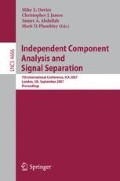Abstract
Functional Data Analysis (FDA) is used for datasets that are more meaningfully represented in the functional form. Functional principal component analysis, for instance, is used to extract a set of functions of maximum variance that can represent the data. In this paper, a method of Mutual Interdependence Analysis (MIA) is proposed that can extract an equally correlated function with a set of inputs. Formally, the MIA criterion defines the function whose mean variance of correlations with all inputs is minimized. The meaningfulness of the MIA extraction is proven on real data. In a simple text independent speaker verification example, MIA is used to extract a signature function per each speaker, and results in an equal error rate of 2.9 % in the set of 168 speakers.
Access this chapter
Tax calculation will be finalised at checkout
Purchases are for personal use only
Preview
Unable to display preview. Download preview PDF.
References
Jolliffe, I.T.: Principal Component Analysis, 2nd edn. Springer, Heidelberg (2002)
Ramsay, J.O., Silverman, B.W.: Functional Data Analysis, 2nd edn. Springer, Heidelberg (2006)
Oja, E.: Principal components, minor components, and linear neural networks. Neural Networks 5, 927–935 (1992)
Tipping, M.E., Bishop, C.M.: Probabilistic principal component analysis (Series B). Journal of the Royal Statistical Society 61(3), 611–622 (1999)
Williams, C., Agakov, F.: Products of gaussians and probabilistic minor components analysis. Neural Computation 14(5), 1169–1182 (2002)
Thompson, P.A.: An adaptive spectral analysis technique for unbiased frequency estimation in the presence of white noise. Systems and Computers, 529–533 (1980)
Xu, L., Oja, E., Suen, C.Y.: Modified hebbian learning for curve and surface fitting. Neural Networks 5, 441–457 (1992)
Moon, T.K., Stirling, W.C.: Mathematical methods and algorithms for signal processing. Prentice-Hall, Upper Saddle River, NJ (2000)
Welling, M., Agakov, F., Williams, C.K.I.: Extreme components analysis. In: Thrun, S., Saul, L., Schölkopf, B. (eds.) Advances in Neural Information Processing Systems 16, MIT Press, Cambridge, MA (2004)
Rao, Y.N., Principe, J.: Efficient total least squares method for system modeling using minor component analysis. In: Proceedings of international workshop on neural networks for signal processing, pp. 259–268 (2002)
Horn, R.A., Johnson, C.R.: Matrix Analysis. Cambridge University Press, Cambridge (1999)
Hyvärinen, A., Karhunen, J., Oja, E.: Independent component analysis. John Wiley and Sons, Chichester (2001)
Garofolo, J.S., Lamel, L.F., Fisher, W.M., Fiscus, J.G., Pallett, D.S., Dahlgren, N.L., Zue, V.: Timit acoustic-phonetic continuous speech corpus. CDROM (1993)
Rosca, J., Kofmehl, A.: Cepstrum-like ica representations for text independent speaker recognition. In: ICA, pp. 999–1004 (2003)
Deng, L., O’Shaughnessy, D.: Speech Processing: A Dynamic and Optimization-Oriented Approach. Signal Processing and Communications. Marcel Dekker, Inc. (2003)
Author information
Authors and Affiliations
Editor information
Rights and permissions
Copyright information
© 2007 Springer-Verlag Berlin Heidelberg
About this paper
Cite this paper
Claussen, H., Rosca, J., Damper, R. (2007). Mutual Interdependence Analysis (MIA). In: Davies, M.E., James, C.J., Abdallah, S.A., Plumbley, M.D. (eds) Independent Component Analysis and Signal Separation. ICA 2007. Lecture Notes in Computer Science, vol 4666. Springer, Berlin, Heidelberg. https://doi.org/10.1007/978-3-540-74494-8_56
Download citation
DOI: https://doi.org/10.1007/978-3-540-74494-8_56
Publisher Name: Springer, Berlin, Heidelberg
Print ISBN: 978-3-540-74493-1
Online ISBN: 978-3-540-74494-8
eBook Packages: Computer ScienceComputer Science (R0)

